site search
online catalog
EARLY BARRACKS OR CAMP SHOE BY JOHN MUNDELL OF PHILADELPHIA
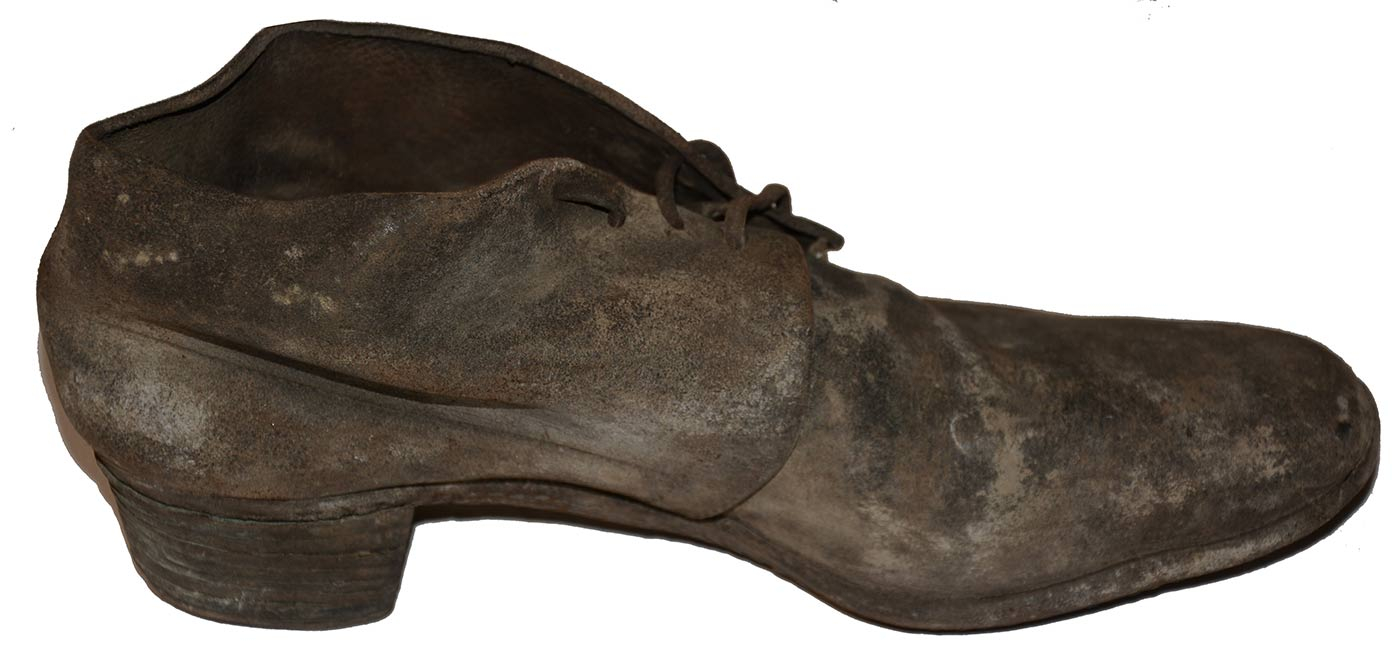
Hover to zoom

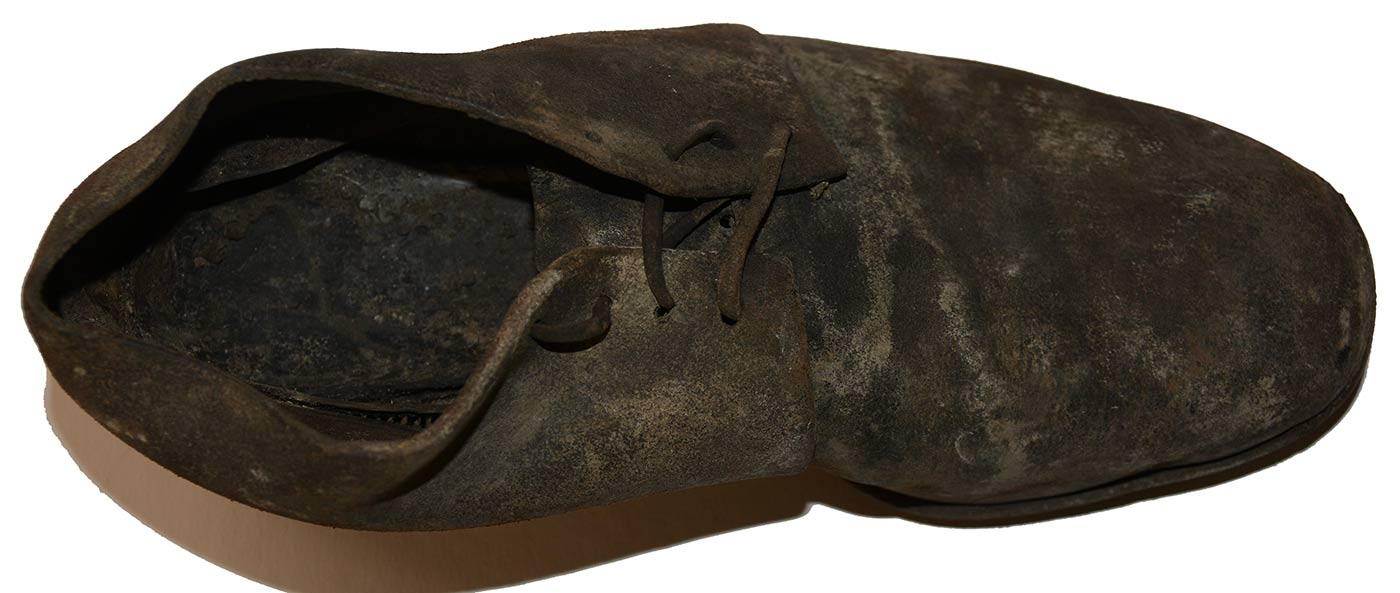
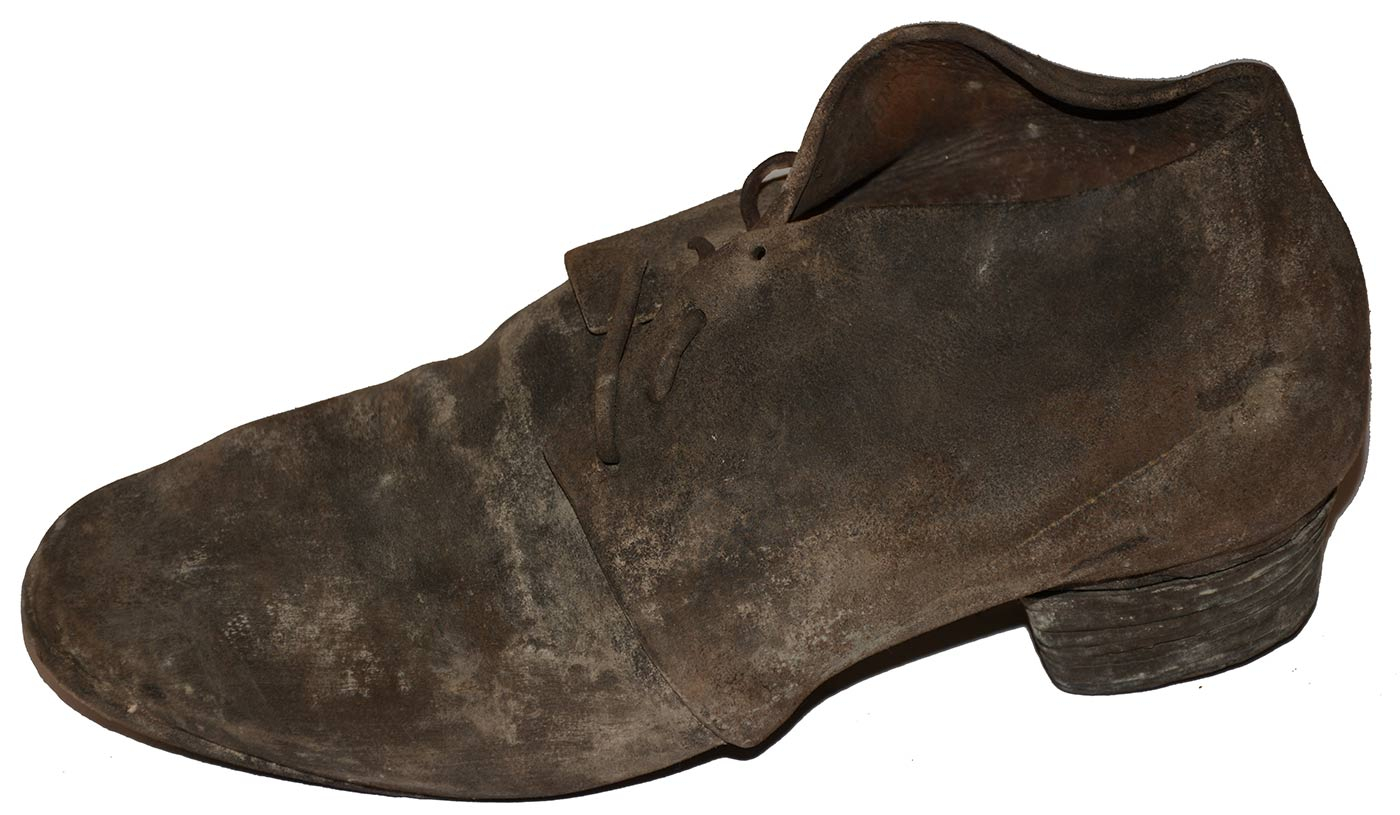
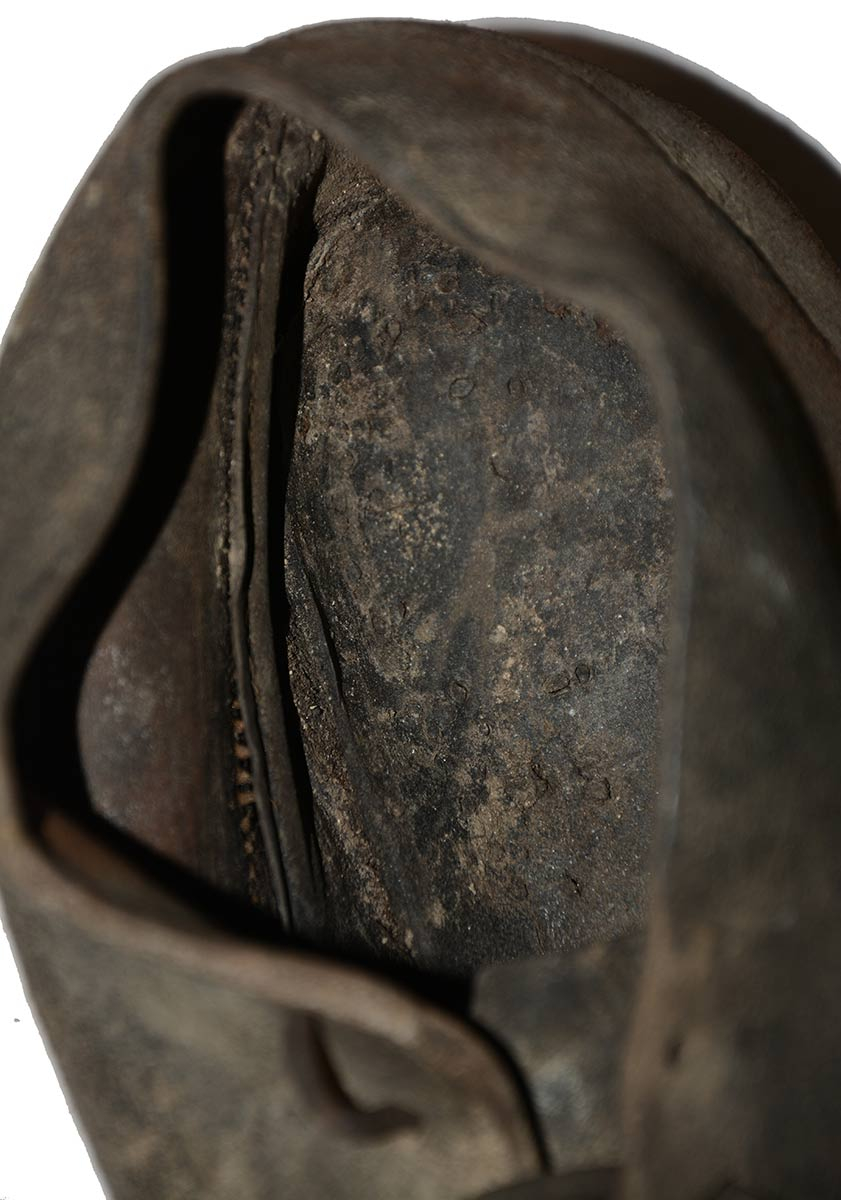
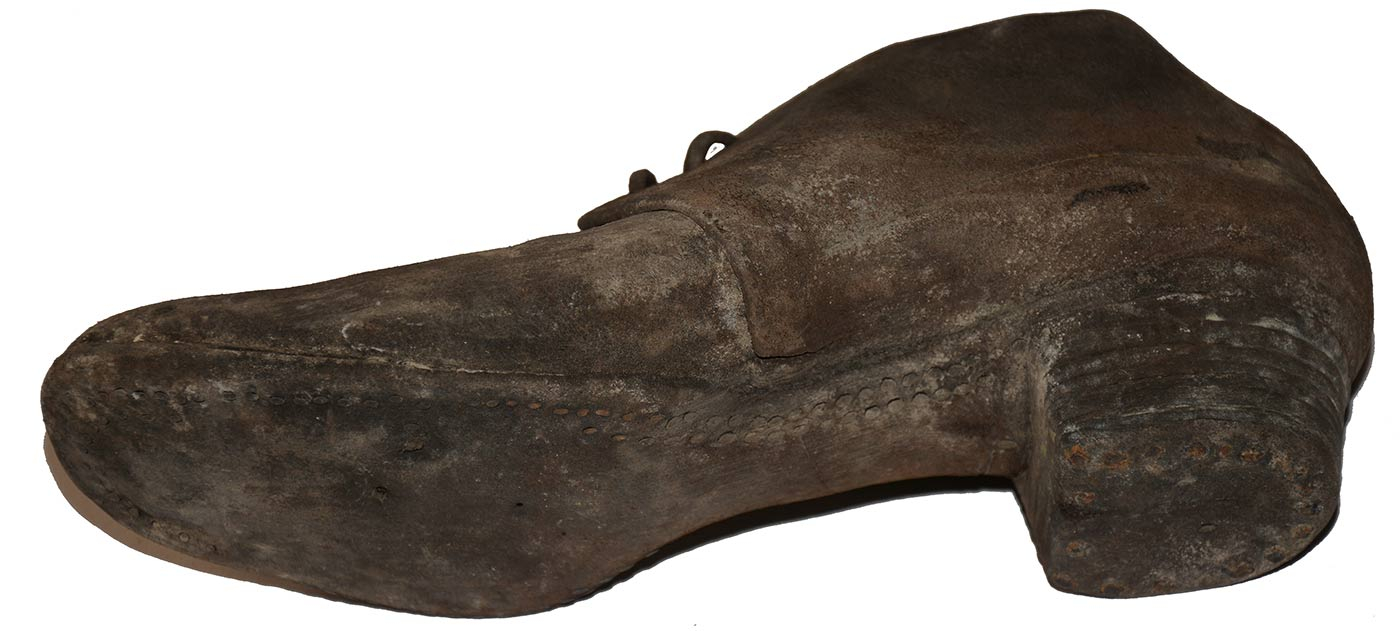
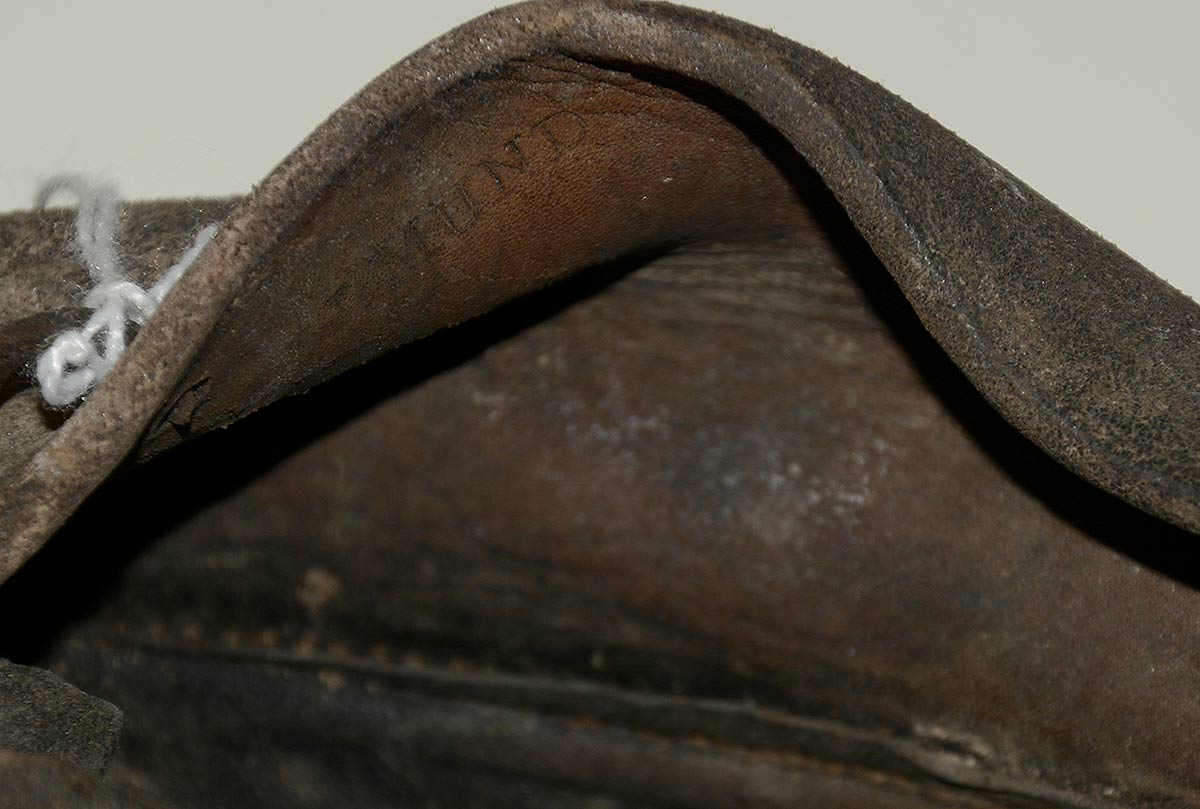
$1,295.00
Quantity Available: 1
Item Code: 1052-388
Shipping: Determined by Method & Location of buyer
To Order:
Call 717-334-0347,
Fax 717-334-5016, or E-mail
This is a usual soldier’s shoe from Fort Pembina, ND, a small U.S. army post from 1870 to 1895, and is typical army construction using rough-side out black leather and is clearly stamped “J. MUNDELL” inside the ankle on the wearer’s right. Mundell was Philadelphia shoe manufacturer with military contracts during the Civil War and also in 1872 for the new pattern field shoes with brass scewed soles. This has Civil War characteristics in its overall pattern using rough-side-out leather, black in color, oxidizing toward brown, with the uppers consisting of typical vamp and quarters with sewn counter inside, and a pegged sole. There are four lacing holes on either side. Part of the original leather thong/lace is present. There is a short ½ inch tear on the bottom of the left instep, where the quarter meets the sole, but the leather is stiff and everything is solid and stable. There are two or three very small holes in the sole at the ball of the foot. The heel is present, firmly in place and is made up of eight stacked pieces of leather nailed in place and still tight. The nails show some corrosion.
The rounded toe of the shoe, the narrow width of the sole at the instep, however, and the rather high heel remind us of the later issue barrack or camp shoes, rather than field shoes. Those used in the 1880s were much different, but we wonder whether Mundell might have experimented with a camp shoe around the same time, 1872, that he was requested by the government to furnish a new pattern of field shoe using brass screws to secure the soles, whose stitching or pegs the army found were damaged by the rough ground and dry conditions of the southwest. This may have been an experimental shoe for government trial or, perhaps more likely, a commercially available shoe marketed to soldiers for more comfortable wear in garrison, camp or barracks, where they might pass for government issue on casual inspection, but be much more comfortable. See McChristian, Uniforms, Arms and Equipment- The US Army on the Western Frontier 1880-1892 for details on the later versions of the barracks shoe and issues regarding their adoption.
John Mundell was born in Ireland and settled in Philadelphia in 1847, going into the shoe trade, with his first experience, “in the government shoe factory in the Schuylkill Arsenal.” In the mid-1850s he partnered in making a “special shoe for the southern trade,” which was likely a polite way of saying he sold cheap shoes to plantation owners for their enslaved workers, and later used this experience in making army shoes on contract in the Civil War, shoes that were sometimes referred to as, “negro brogans.” A short biography can be found in Vol. 3, 281-286, of Prominent and Progressive Pennsylvanians of the Nineteenth Century (Williamson et al. 1898,) and also states that in 1872 he was requested to make shoes and boots for the Army on the new pattern, using brass screws to secure the soles instead of sewing- a necessity made clear by campaigns on the rocky ground of the American southwest.
Of his military work, his short biography says:
“He soon secured work at the Government shoe factory in the Schuylkill Arsenal, and , within a year after he had arrived in Philadelphia in want , he entered upon business as a shoemaker on his own account . He was successful in his modest venture, and in 1855 began the manufacturing, with the Joseph H. Thompson Company, of a special shoe for the Southern trade, and when the Civil War came the firm had ten thousand dollars' worth of these goods on hand. With what money he could raise on this stock he bid for and secured contracts for army shoes, his first order being for four thousand pairs, followed soon after by another for twenty thousand pairs. In 1863 the introduction of a new machine in the business and a strike of Philadelphia shoemakers were the causes of many contracts going to New England manufacturers; but Mr. Mundell continued making his high-grade shoes and filled his contracts with regularity , and at the close of the conflict he was highly complimented by the Inspector-General with having furnished the best shoes that were supplied to the army.
In 1870 was formed the present firm of John Mundell & Company. In 1872 the firm, at the request of the Government, made what was termed the “Standard” boot and shoe, the soles being fastened by brass screws instead of being sewed. These were sent to troops on the Western outposts that they might be tested by the roughest service, and the reports all spoke so favorably of them that they were adopted as the regulation shoe . . . “
This shoe is complete, very displayable, with the leather hard, stable, and able to be handled. By appearance and feel this would be taken as a barn or attic-find, but was in fact excavated at in Fort Pembina, on private property and with the owner’s permission, in wonderful anaerobic conditions that have yielded cloth and leather in remarkable condition. (Think of the British Roman fort a Vindolanda, which has offered up two-thousand year-old sandals, writing tablets, etc., in excellent condition.) In this case the military fort was a U.S. Army Indian War post situated in the Red River Valley in North Dakota near the Canadian border, established in 1870 and in operation until 1895. Trading posts existed earlier in the area as part of the fur trade, and the first U.S. military post there was temporary- manned by a detachment of Minnesota troops in 1863-1864 following the 1862 Sioux uprising. In March 1870 a new fort was established south of the Pembina River and about 200 yards west of the Red River, completed by July and named in honor of Gen. George H. Thomas. The name was changed to Fort Pembina in September and the initial garrison consisted of two companies of the 20th US Infantry and excavations show that, as is typical of the early Indian Wars regular army, their uniforms and gear were a mix of Civil War surplus issue, private purchase material, and later army issue patterns and private purchases as time went on. Their main duty was to provide security for settlers worried about Sioux returning south from Canada, but the troops were more occupied with escorting boundary surveys along the Canadian border and preventing Fenian raids heading north into Canada.
The fort included enlistedmen’s barracks, officers’ quarters, guard house, ordnance storehouse, company kitchen, root house, laundress’s quarters, quarters for civilian employees, hospital and hospital servant’s house, a barn for the “hospital cow,” quartermaster and commissary offices and storehouse, stables, wagon shed, etc. The garrison reached peak strength in 1878 af 200, but the average was about 125 enlisted men and 8 officers. An October 1885 return listed 97 men, 2 field pieces, 1 mountain howitzer, 100 rifles, 19 pistols, 23 mules, and 9 wagons. By 1890 the post had just 23 men, and after an 1895 fire destroyed some 19 buildings it was decided to abandon the fort rather than rebuild, the last detachment left in September. The property was turned over to the Interior Department and later sold in 1902.
This is a very interesting piece of army footwear, both essential and very rare in any case, marked by a maker with well-established military connections. [sr][ph:L]
~~~~~~~~~~~~~~~~~~~~~~~~~~~~~~~~~~~
THIS ITEM, AS WITH ALL OTHER ITEMS AVAILABLE ON OUR WEB SITE,
MAY BE PURCHASED THROUGH OUR LAYAWAY PROGRAM.
CLICK HERE FOR OUR POLICIES AND TERMS.
THANK YOU!
Inquire About EARLY BARRACKS OR CAMP SHOE BY JOHN MUNDELL OF PHILADELPHIA
Most Popular
Historical Firearms Stolen From The National Civil War Museum In Harrisburg, Pa »
Theft From Gravesite Of Gen. John Reynolds »
Selection Of Unframed Prints By Don Troiani »
Fine Condition Brass Infantry Bugle Insignia »
Large English Bowie Knife With Sheath 1870’S – 1880’S »
Imported (Clauberg) Us Model 1860 Light Cavalry Officer's Saber »
featured item
WORLD WAR TWO / KOREA UNITED STATES MARINE CORPS OFFICER’S MAMALUKE SWORD
The drawn sword meas. approx. 36.00 inches long. The blade itself meas. approx. 31.00 inches long x 0.75 of an inch wide at the ricasso. It has a central fuller that starts just above the ricasso and runs for approx. 27.00 inches. The blade surface… (2021-944). Learn More »


